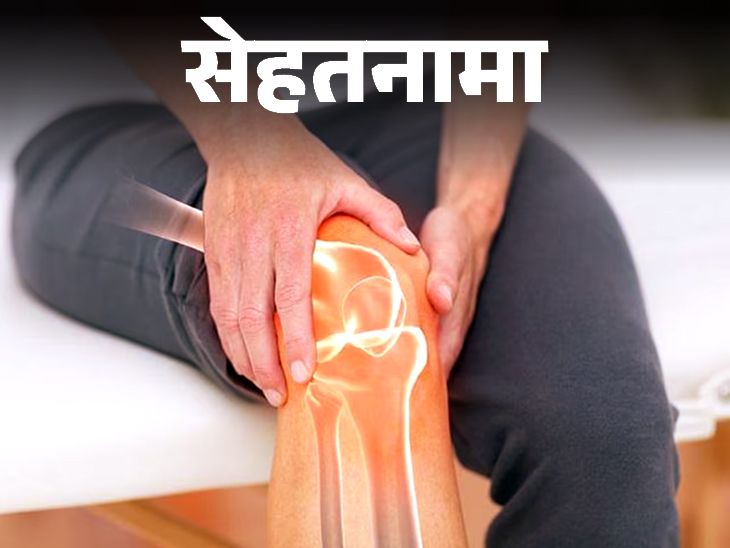29 minutes agoAuthor: Gaurav Tiwari
- copy link

What You have noticed that there is stiffness and pain in the joints in the morning during cold weather. It may be less for some and more for others. Joint pain is quite common in winter.
There are many reasons for increased pain and stiffness in joints in this season. Due to low temperature in cold, blood vessels shrink. Due to this, blood flow reduces and pain is felt more. This can also happen due to less physical activity in winter and change in mood.
In such a situation, for those who are suffering from arthritis, their difficulties increase further in this season. According to the World Health Organization (WHO), 528 million people across the world have osteoarthritis. About 1 crore 76 lakh people in the world have rheumatoid arthritis.
All these people have swelling in their joints, which increases further in winter. Due to this the pain also increases. Sometimes it becomes difficult for them to even walk in winter. Now the question is what is the way to deal with this pain.
so today ‘medical certificate‘I will talk about joint pain in winter. You will also learn that-
- Why does joint pain increase when cold increases?
- What should be done to deal with this?
- Can food help with this?
Joint pain increases in winter
According to a study published in the ‘National Library of Medicine’ in March 2014, the symptoms of arthritis increase in winter. 67.2% of the people suffering from osteoarthritis included in this study complained that swelling and pain in their joints increases as the cold increases.

Why does pain increase with increasing cold?
When the cold increases, our brain gives a message to the body that the major organs of the body need heat to stay alive. As soon as the message is received, the body increases blood flow towards the most important organs. We shiver in cold because the body tries to maintain warmth by activating the muscles.
To keep blood in the body’s core organs, blood vessels become tight and contract. Its disadvantage is that blood flow in hands and legs reduces. The warmth in hands and feet also reduces. Due to this the fluid of the joints becomes thick. This condition causes stiffness and pain in the joints.
What are the other reasons for increasing joint pain as the temperature decreases in winter? See the graphic below:

Orthopedics Dr. Yogesh says that change in mood due to cold can also be a major reason for joint pain. Generally there is lack of awareness about this among people. In fact, increasing cold increases anxiety and depression.
According to a study published in the ‘National Library of Medicine’ in September 2018, if someone is feeling emotionally low, then he feels pain more than others.
How to avoid joint stiffness and pain
Dr. Yogesh says that we can deal with joint pain by making some small changes in our lifestyle.
- Do not leave the house in the morning and evening to avoid direct exposure to cold. Try to complete all the work outside the house during the day.
- To maintain body heat, wear warm clothes and shoes.
- To keep your body active, do indoor exercise for some time.
- Most people’s liquid intake reduces in cold. This may cause dehydration. This can cause stiffness in the joints and loss of fluid. This causes pain. Therefore it is important to keep the body hydrated.
- Due to increased physical and mental stress, pain is felt more than normal. Therefore stress management is very important.
- In case of joint pain, the first thing doctors recommend is to control weight. Being overweight puts more pressure on the joints, due to which the symptoms become severe. Therefore weight management is very important.
Apart from this, what other methods can help in dealing with joint pain, see the graphic:

Follow anti inflammatory diet
Dr. Yogesh says that inflammation is the main reason behind joint pain. The body’s immune response increases to protect against cold in winter. Due to this, inflammation increases and joint pain also increases. To deal with pain, it is important to follow an anti-inflammatory diet. For this you can follow these tips:
- You can include fruits and vegetables of all colors in your diet.
- Can include oats, rye, millet, quinoa and brown rice.
- All can include pulses, gram, black beans and red kidney beans.
- One should be more cautious regarding oil in the diet. Can include olive oil.
- Can include almonds, walnuts, chia seeds and flax seeds.
- May include ginger, garlic, turmeric, cardamom, black pepper and cinnamon.
- You can eat curd, cheese and banana which are beneficial for gut health.
- Avoid processed, ultraprocessed food, refined carbs and sugar in your diet.
Eat seasonal fruits and vegetables
The body has to face different difficulties in every season. To deal with these, nature grows fruits and vegetables according to the season.
- Amla, guava and orange are winter fruits and they are anti-inflammatory.
- Cauliflower, cabbage, broccoli and carrots are winter vegetables and they are anti-inflammatory.
- Including these fruits and vegetables in the diet can provide relief from joint stiffness and pain.
Get enough sleep and stay away from smoking
Inflammation can increase due to lack of sleep. Joint fluid may decrease. There may be stiffness in the joints and pain may increase. Therefore, take adequate sleep of 7 hours every day.
Smoking can cause inflammation and weaken bones. Therefore stay away from smoking. …………………. Also read this news of Sehatnama Sehatnama – 34 crore people in the world are suffering from arthritis: WHO’s warning – it will increase further.

According to the World Health Organization (WHO), today more than 34 crore people around the world are suffering from arthritis. Read the full news…



